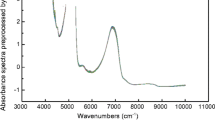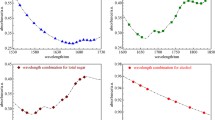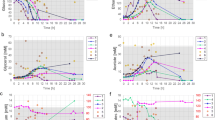Abstract
A new selection procedure of an informative near-infrared (NIR) region for regression model building is proposed that uses an online NIR/mid-infrared (mid-IR) dual-region spectrometer in conjunction with two-dimensional (2D) NIR/mid-IR heterospectral correlation spectroscopy. In this procedure, both NIR and mid-IR spectra of a liquid sample are acquired sequentially during a reaction process using the NIR/mid-IR dual-region spectrometer; the 2D NIR/mid-IR heterospectral correlation spectrum is subsequently calculated from the obtained spectral data set. From the calculated 2D spectrum, a NIR region is selected that includes bands of high positive correlation intensity with mid-IR bands assigned to the analyte, and used for the construction of a regression model. To evaluate the performance of this procedure, a partial least-squares (PLS) regression model of the ethanol concentration in a fermentation process was constructed. During fermentation, NIR/mid-IR spectra in the 10000 – 1200 cm−1 region were acquired every 3 min, and a 2D NIR/mid-IR heterospectral correlation spectrum was calculated to investigate the correlation intensity between the NIR and mid-IR bands. NIR regions that include bands at 4343, 4416, 5778, 5904, and 5955 cm–1, which result from the combinations and overtones of the C–H group of ethanol, were selected for use in the PLS regression models, by taking the correlation intensity of a mid-IR band at 2985 cm−1 arising from the CH3 asymmetric stretching vibration mode of ethanol as a reference. The predicted results indicate that the ethanol concentrations calculated from the PLS regression models fit well to those obtained by high-performance liquid chromatography. Thus, it can be concluded that the selection procedure using the NIR/mid-IR dual-region spectrometer combined with 2D NIR/mid-IR heterospectral correlation spectroscopy is a powerful method for the construction of a reliable regression model.
Similar content being viewed by others
References
Y. Ozaki, Anal. Sci., 2012, 28, 545.
K. A. Lee, “Near-Infrared Spectroscopy in Food Science and Technology”, ed. Y. Ozaki, W. F. McCluer, and A. A. Christy, 2006, Chap. 9, Wiley Interscience, New York, 361.
M. B. Simpson, “Process Analytical Technology: Spectroscopic Tools and Implementation Strategies for the Chemical and Pharmaceutical Industries”, ed. K. A. Bakeev, 2nd ed., 2010, John Wiley & Sons, Ltd., Chichester, UK, 107.
M. Watari, Opt. Rev., 2010, 17, 317.
J. H. Jiang, R. J. Berry, H. W. Siesler, and Y. Ozaki, Anal. Chem., 2002, 74, 3555.
Y. P. Du, Y. Z. Liang, J. H. Jiang, R. J. Berry, and Y. Ozaki, Anal. Chim. Acta, 2004, 501, 183.
T. Genkawa, M. Watari, T. Nishii, and Y. Ozaki, Appl. Spectrosc., 2012, 66, 773.
I. Noda, Appl. Spectrosc., 1993, 47, 1329.
I. Noda, A. E. Dowrey, and C. I. Marcott, Appl. Spectrosc., 1993, 47, 1317.
I. Noda and Y. Ozaki. “Two-dimensional Correlation Spectroscopy—Applications in Vibrational and Optical Spectroscopy—”, 2004, John Wiley & Sons Ltd., Chichester, UK, 1.
I. Noda, Anal. Sci., 2007, 23, 139.
T. Amari and Y. Ozaki, Macromolecules, 2002, 35, 8020.
B. Czarnik-Matusewicz, S. Pilorz, and J. P. Hawranek, Anal. Chim. Acta, 2005, 544, 15.
R. A. Cocciardi, A. A. Ismail, Y. Wang, and J. Sedman, J. Agric. Food Chem., 2006, 54, 6475.
S. Watanabe, I. Noda, and Y. Ozaki, J. Mol. Struct., 2008, 883–884, 173.
S. Watanabe, I. Noda, and Y. Ozaki, Polymer, 2008, 49, 774.
A. Aït Kaddour, M. Mondet, and B. Cuq, J. Cereal Sci., 2008, 48, 678.
V. R. Kondepati and H. M. Heise, Curr. Trends Biotechnol. Pharm., 2008, 2, 117.
R. Nagarajan, A. Gupta, R. Mehrotra, and M. M. Bajaj, J. Autom. Methods Manage. Chem., 2006, 2006, 1.
A. G. Cavinato, D. M. Mayes, Z. Ge, and J. B. Callis, Anal. Chem., 1990, 62, 1977.
M. Blanco, A. C. Peinado, and J. Mas, Biotechnol. Bioeng., 2004, 88, 536.
V. Di Egidio, N. Sinelli, G. Giovanelli, A. Moles, and E. Casiraghi, Eur. Food Res. Technol., 2010, 230, 947.
S. Burikov, T. Dolenko, S. Patsaeva, Y. Starokurov, and V. Yuzhakov, Mol. Phys., 2010, 108, 2427.
Author information
Authors and Affiliations
Corresponding author
Rights and permissions
About this article
Cite this article
Nishii, T., Genkawa, T., Watari, M. et al. Selection of the NIR Region for a Regression Model of the Ethanol Concentration in Fermentation Process by an Online NIR and Mid-IR Dual-Region Spectrometer and 2D Heterospectral Correlation Spectroscopy. ANAL. SCI. 28, 1165–1170 (2012). https://doi.org/10.2116/analsci.28.1165
Received:
Accepted:
Published:
Issue Date:
DOI: https://doi.org/10.2116/analsci.28.1165




